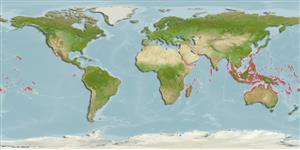>
Carangiformes (Jacks) >
Carangidae (Jacks and pompanos) > Trachinotinae
Etymology: Trachinotus: Greek, trachys, -eia, -ys = rough + Greek,noton = back (Ref. 45335).
More on author: Lacepède.
Environment: milieu / climate zone / depth range / distribution range
Ecología
marino; salobre asociado a arrecife; rango de profundidad 0 - 3 m (Ref. 89972). Tropical; 32°N - 32°S
Indo-Pacific: Red Sea to the Line and Mangaréva islands, north to southern Japan, south to Lord Howe and Rapa.
Tamaño / Peso / Age
Maturity: Lm ? range ? - ? cm
Max length : 60.0 cm TL macho / no sexado; (Ref. 4225); common length : 35.0 cm TL macho / no sexado; (Ref. 5450); peso máximo publicado: 1.5 kg (Ref. 30874)
Espinas dorsales (total): 7; Radios blandos dorsales (total): 20-24; Espinas anales 3; Radios blandos anales: 20 - 24.
Adults occur near surface waters of lagoon and seaward reefs, in surge zones along sandy beaches (Ref. 48635, 90102). They always move in schools at the edge of the surf near the reef, usually in pairs or small groups in surface waters (Ref. 48635). They feed on small fishes (Ref. 9710). They are occasionally taken by trolling and line fishing.
Life cycle and mating behavior
Madurez | Reproducción | Puesta | Huevos | Fecundidad | Larva
Paxton, J.R., D.F. Hoese, G.R. Allen and J.E. Hanley, 1989. Pisces. Petromyzontidae to Carangidae. Zoological Catalogue of Australia, Vol. 7. Australian Government Publishing Service, Canberra, 665 p. (Ref. 7300)
IUCN Red List Status (Ref. 130435)
Threat to humans
Harmless
Human uses
Pesquerías: escaso valor comercial; pesca deportiva: si
Más información
ReferenciasAcuiculturaPerfil de acuiculturaRazasGenéticaElectrophoresesheritabilidadEnfermedadesProcesamientoNutrientsMass conversion
Herramientas
Special reports
Download XML
Fuentes de Internet
Estimates based on models
Preferred temperature (Ref.
123201): 24.7 - 29.3, mean 28.4 °C (based on 3280 cells).
Phylogenetic diversity index (Ref.
82804): PD
50 = 0.5000 [Uniqueness, from 0.5 = low to 2.0 = high].
Bayesian length-weight: a=0.01259 (0.00582 - 0.02724), b=2.96 (2.77 - 3.15), in cm total length, based on LWR estimates for this (Sub)family-body shape (Ref.
93245).
Nivel trófico (Ref.
69278): 3.6 ±0.52 se; based on food items.
Resiliencia (Ref.
120179): Medio, población duplicada en un tiempo mínimo de 1.4-4.4 años (Preliminary K or Fecundity.).
Fishing Vulnerability (Ref.
59153): Moderate vulnerability (44 of 100).
Nutrients (Ref.
124155): Calcium = 59.6 [27.7, 127.3] mg/100g; Iron = 0.837 [0.442, 1.569] mg/100g; Protein = 19.9 [17.9, 21.9] %; Omega3 = 0.113 [0.065, 0.209] g/100g; Selenium = 18.4 [9.9, 37.0] μg/100g; VitaminA = 80.1 [22.5, 267.8] μg/100g; Zinc = 1.2 [0.8, 1.7] mg/100g (wet weight);
